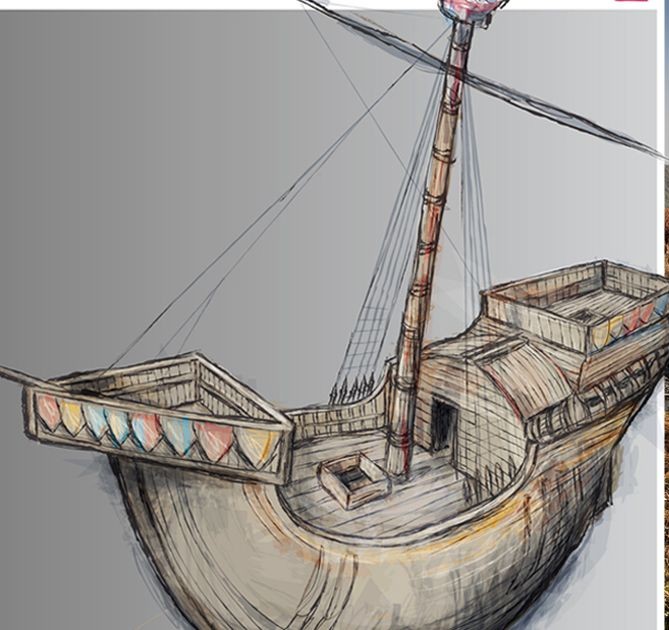As part of stage two of the Road To Agincourt, From Tree to Sea, the team will be looking at the aftermath of the Battle of Agincourt. One of the many exciting projects we have lined up is an archaeological dig around the wreck of the Grace Dieu, a battleship which sank in the River Hamble.
The Grace Dieu was the fourth of Henry V’s greatest warships, constructed for the battle with France. It was assembled in Southampton between 1416 and 1418 and at the time was the largest ship built in England. It wouldn’t be for another 200 years until a bigger ship was built in England.
 The ship was constructed to a clinker built design, and weighing in at 1,400 tons meant that a dock was specially built for the structure in Southampton.
The ship was constructed to a clinker built design, and weighing in at 1,400 tons meant that a dock was specially built for the structure in Southampton.
But despite the design intentions, Grace Dieu was never used for battle and only sailed one voyage. The ship became fully operational in 1420, and therefore she was no longer needed as by this point England already had control of the Channel. Instead, she made her maiden voyage under the command of the Earl of Devon during the same year. However, whilst at sea a number of the men from Devon mutinied soon after leaving Southampton, leading to the expedition diverting to St Helens on the Isle of Wight. Grace Dieu was never put to sea again after these events.
By the end of 1420, Grace Dieu was moored in the River Hamble and was said to serve as a political reminder to foreign visitors to the country that England was capable of claiming power over the seas. Henry V died just two years after Grace Dieu’s only voyage and most of his ships were considered his personal property rather than the ships of the Royal Navy. These ships were therefore sold to pay off his remaining debts, whereas Grace Dieu remained in the River Hamble.
Grace Dieu was visited in 1430 by William Soper, who was in charge of the administration of the navy, and he dined on board with the command of the Florentine merchant. It was discovered in the commands diary that he had never seen “so large and splendid a construction.” Four years later the ship was towed up the River Hamble to Bursledon and laid in the mudflats, where the wreck remains today.
Nine years after William Soper’s visit, Grace Dieu was sadly struck by a bolt of lightning and burnt to the shoreline. Although some parts of the ship were salvaged, the wreckage still remains sunken in the mud in the River Hamble. There is actually local rumour that the shipkeeper at the time decided to burn the ship after plundering and selling too many materials from her, and blamed the lightening as a cover up. However, this story has never been proven to be true.
But the history of Grace Dieu doesn’t end there… The remains of Grace Dieu would surface from the river at extreme low tides, which led the Victorians to mistakenly believe that the wreck was actually a Viking ship due to the clinker build. It wasn’t until 1934 that R.C Anderson suggested that the wreck must actually the remains of the Grace Dieu.
 In 1970, the University of Southampton bough the wreck for just £5 and the care now lies with the Department of Archaeology and it has been designated as a protected wreck site. Before this the ownership of the wreck previously lay with the British Crown. It can now be stated that the wreck is Grace Dieu with certainty, due to the evidence that the ship was laid at the location and the fact that the remains are “too big to be anything else”.
In 1970, the University of Southampton bough the wreck for just £5 and the care now lies with the Department of Archaeology and it has been designated as a protected wreck site. Before this the ownership of the wreck previously lay with the British Crown. It can now be stated that the wreck is Grace Dieu with certainty, due to the evidence that the ship was laid at the location and the fact that the remains are “too big to be anything else”.
The ship has been investigated many times by various research and archaeology centres. It was even investigated by Channel 4s Time Team 2004. More fieldwork is being planned by the CMA for the future…
If you wish to visit the site of the remains of Grace Dieu, the wreckage is marked by a yellow cross on the River Hamble near Manor Farm Country Park. It is easily seen from the pontoon, which is a 15 minute walk from Barnfield. Also seen at Barnfield is the play structure designed by Richard James, which is inspired by the Grace Dieu.
The Road To Agincourt team hope to transform the woodland path leading to Grace Dieu into a beautiful, interactive and guided walkway with the help of an awarded grant from Tesco’s #BagsofHelp scheme. Click here for more information on the scheme.



Recent Comments